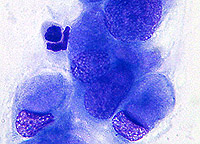This is a slow motion infection. Proceeds almost asymptomatic. A person most often does not suspect that it is a carrier of a formidable disease that can cause prostatitis and infertility.
Content
 Mycoplasmas, ureaplasma are microorganisms that occupy an intermediate position between bacteria, mushrooms and viruses. They cannot exist independently, as they parasitize on the cells of the host cell, getting the basic nutrients of them. Usually mycoplasmas, ureaplasma are attached to the cells of the epithelium of intestinal, respiratory and urinary tracts.
Mycoplasmas, ureaplasma are microorganisms that occupy an intermediate position between bacteria, mushrooms and viruses. They cannot exist independently, as they parasitize on the cells of the host cell, getting the basic nutrients of them. Usually mycoplasmas, ureaplasma are attached to the cells of the epithelium of intestinal, respiratory and urinary tracts.
These diseases are widespread among the population (ureaplasmosis, and not ureoplasmosis; ureaplasm, and not ureoplasm). They are transmitted during sexual contacts, and many researchers refer them to venereal diseases.
According to a number of authors (and.AND. Mavrov, 1987; IN.IN. Deleign and Sovt., 1987), the difficulty of diagnosis, the prevalence and inadequacy of the therapy led to the predominance of these infections over «Classical» Venusal diseases.
It was noted that in 83-87% of cases of ureaplasma were allocated from women who had contact with men, patients with non-smooth urethriters of urea- or mycoplasma nature, as well as carriers ureaplasm, mycoplasmas.
For humans are pathogenic four types:
- Mycoplasma pneumoniae,
- Mycoplasma genitalium,
- Mycoplasma Hominis,
- Ureaplasma urealyticum.
And the last three are causative agents of urinary mycoplasmosis, urogenital ureaplasmosis, which currently occupy a significant place among sexually transmitted infections (STIs), and Mycoplasma Pneumoniae is striking the respiratory system (throat, lungs, bronchi). Mycoplasmosis can cause premature labor, early detection of accumulating waters, fever during childbirth and in the postpartum period in mothers, the development of inflammation of lungs, meningitis in children, morphological changes in sperm, lead to the development of urethritis, cystitis, adnexitis, salpingooforita, erosy of the cervix.
Selection of medicines for the treatment of these diseases are determined by the peculiarities of the biology of pathogens. Mycoplasma, ureaplasma is resistant to all drugs, the action of which is associated with the biosynthesis of cell wall proteins, as well as to sulfonamide preparations, penicillin, streptomycin.
Treatment is necessarily carried out with a permanent sexual partner, otherwise re-infection (infection) inevitably. This is a rather complicated process, because mycoplasms, ureaplasma are very resistant to sulfonilamides and antibiotics of penicillin rows and are often found with other sexually transmitted infections (STIs), venereal diseases (syphilis, gonoronia, trichomoniasis, chlamydia, etc.).
Covering control is carried out by bacteriological study of sex tract smears after the end of treatment with various methods (microbiological, PCR analysis).
Mycoplasmosis, ureaplasmosis is the cause of urethritis, prostatitis, postpartum endometritis, spontaneous abortion, premature genera, vaginitis, cystitis, salpingitis, so, be sure to immediately visit the venereologist, do not try to cure yourself and do not let everything on samonek.
Currently, more than two dozen methods of diagnosing mycoplasmosis in various samples of biological material are available. This is microbiological sowing for special nutrient media, methods for serological identification of colonies on a dense medium. It is possible to identify in the clinical material of mycoplasma antigen and antibodies.
Since mycoplasma infection is currently usually found with other pathogens and diseases (syphilis, gonorads, trichomoniasis, chlamydia of fungal diseases, herpesa dr.). These diseases and infections must also be diagnosed and treated.
For analyzes for mycoplasms, ureaplasma uses microbiological, serological laboratory methods, as well as the PCR method . With suspected prostatitis, it is necessary to investigate the secret of the prostate gland (prostate), and with men's infertility - sperm.
Man is a natural owner of at least 14 types of mycoplasm, among which M is most often allocated.Pneumoniae, M.Genitalium, M.Hominis, M.Fermentans, ur.urealyticum. Therefore, the main role in the prevention is played by the early diagnosis of venereal diseases and infections.
The prevention of mycoplasmosis also includes a survey on a urogenital infection of marriage, newborns, compliance with sanitary and hygienic standards and a sterilization regime in medical institutions; Chlorination and disinfection of water in pools and sanitary and educational work.
In venereology, it is necessary to conduct a systematic medical examination for the identification of mycoplasmosis, ureaplasmosis in groups «Increased risk» (Prostitutes, Homosexuals). In gynecology, a directional examination of pregnant women at different stages of pregnancy is of great importance.
In urology, high-risk groups should be allocated (persons who need kidney transplantation and t.D.). Timely identification and treatment of mycoplasmosis, ureaplasmosis is necessary for the prevention of ascending gynecological and urological and infection.









